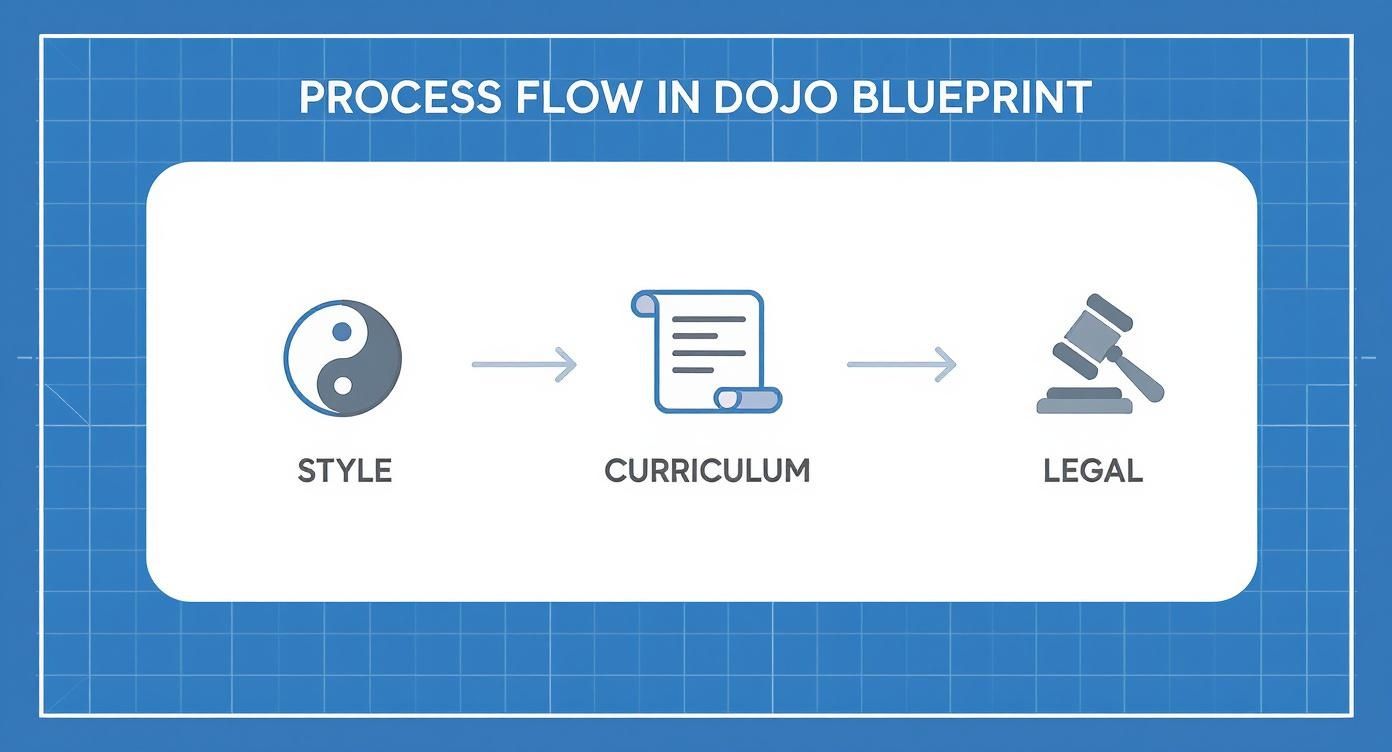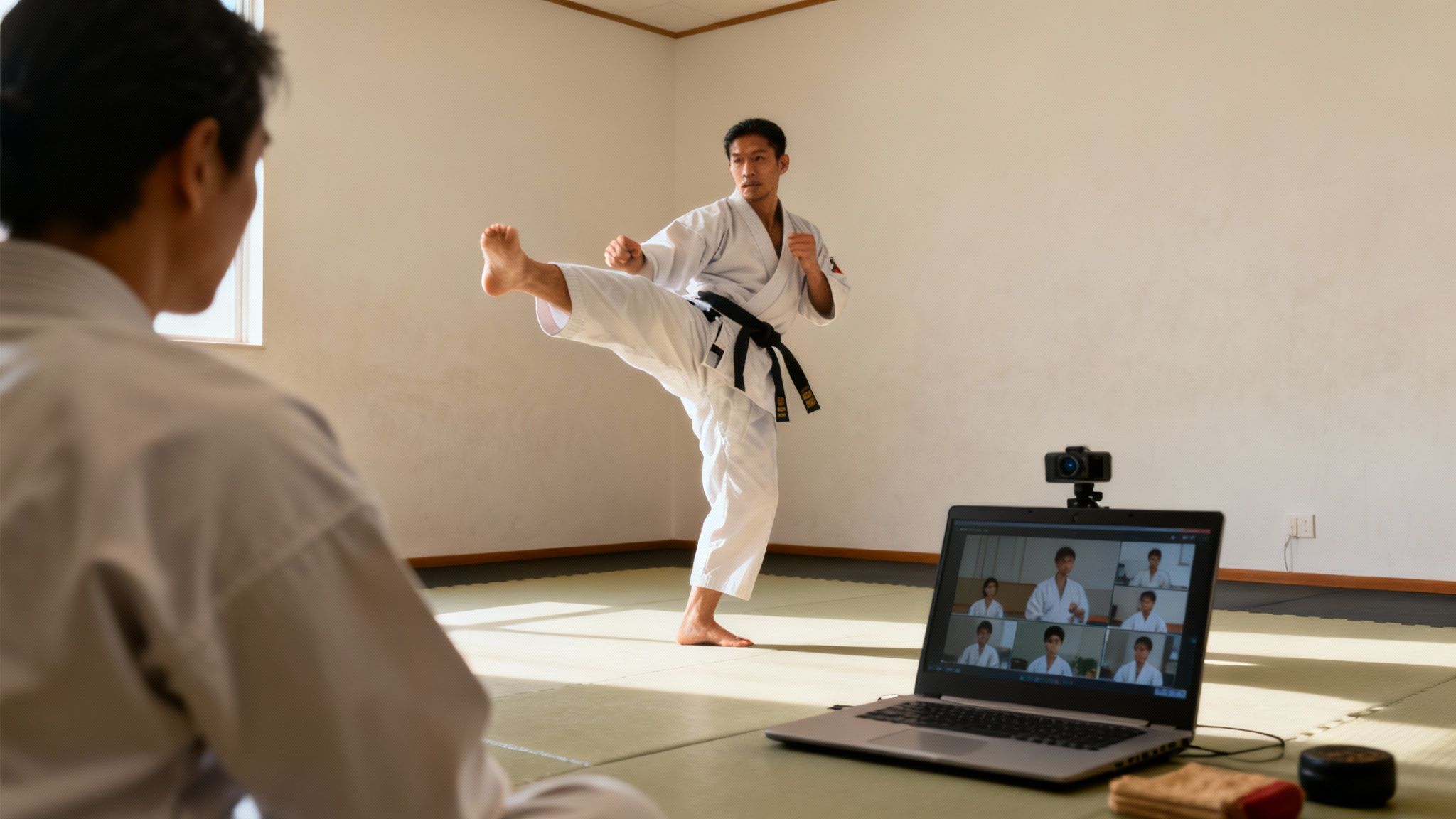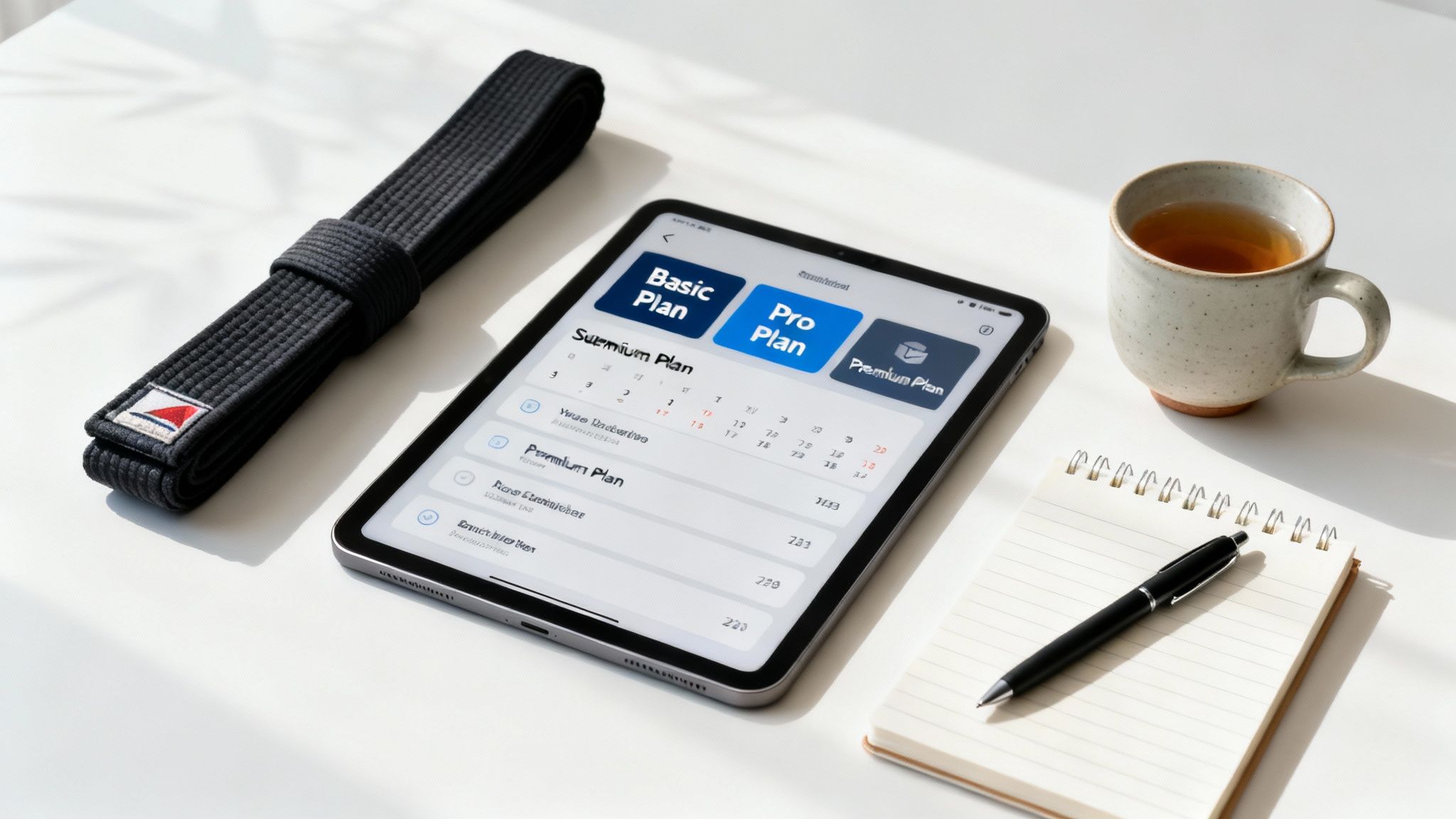

Launch a successful online martial arts class with our guide. Get practical strategies on tech, marketing, and teaching to build your virtual dojo.
Before you hit "go live" on your first online martial arts class, you need a solid blueprint. This isn't just about setting up a good camera; it's about defining your teaching style, crafting a safe digital curriculum, and getting your legal ducks in a row. A great online experience starts with a plan.
Taking your dojo digital means more than just pointing a camera at the mats. You have to strategically recreate the discipline, community, and effectiveness of in-person training through a screen. Without this foundation, even the most gifted instructor will struggle to connect with students. This blueprint is the framework that ensures your virtual dojo is built to last.
The big shift to online classes really kicked off during the COVID-19 pandemic, completely changing how martial arts are taught. In 2020, as lockdowns shut down physical studios, the number of schools offering online options shot up by over 150% worldwide. By 2021, over 35% of martial arts studios had settled into hybrid models, blending in-person with virtual classes.
This all comes down to defining your style, building your curriculum, and covering your legal bases.

As you can see, a successful online dojo is built on three pillars: a distinct teaching style, a well-structured curriculum, and solid legal groundwork.
First things first: who are you teaching? Are you focused on absolute beginners who need the basics broken down, or kids who need high-energy, engaging sessions? Maybe you're catering to advanced students looking to sharpen their technique. Your audience shapes everything.
A kids' class, for instance, might lean heavily on gamified drills and short, dynamic segments to keep their attention. An adult class, on the other hand, could prioritize detailed technical breakdowns and conditioning circuits. Your unique style—whether it's traditional and disciplined or modern and fitness-focused—is your brand.
This is the core of what you're offering. It’s what makes a student pick your class over the countless others out there.
Adapting your curriculum for remote training is a huge step. You can’t just walk over and make a physical correction, so your instructions have to be crystal clear and incredibly descriptive.
Break down complex techniques into smaller, bite-sized steps that are easy to follow. Think about which movements can be practiced safely and effectively without a partner or specialized equipment. The curriculum needs to feel progressive, giving students a clear path to build their skills week after week.
A great online curriculum isn't just a list of techniques; it's a journey designed to keep students motivated and progressing safely in their own space. Focus on drills that build coordination, balance, and form without requiring a partner.
To keep things safe and structured, build these elements into every virtual lesson:
The legal side of running online classes is easy to overlook but absolutely critical. Running a business, even a virtual one, requires careful planning to protect yourself.
You'll need liability waivers specifically written for online training. These documents need to clearly outline the risks of practicing martial arts at home. Spending a little to have a legal professional draft these is one of the smartest investments you can make.
Also, have a chat with your insurance provider. You need to confirm that your policy actually covers virtual instruction. Many standard policies for physical dojos don't automatically extend to online activities, and getting the right coverage protects both you and your students.
As you build out your virtual dojo's online home, a professional website is key. This practical guide to website design can help you build a platform that attracts students. For the bigger picture, check out our complete guide on how to build a winning martial arts business plan.
Your technology stack is the backbone of your virtual dojo. Getting it right creates a smooth, professional experience for your students. Getting it wrong leads to laggy, frustrating classes that make people want to quit. This isn't about buying the most expensive gear; it’s about making smart choices that fit your teaching style and your students' needs for every single online martial arts class.

This kind of "gallery view," shown here in Zoom, is a non-negotiable feature. You have to be able to see multiple students at once to offer corrections and maintain that crucial class connection. The right platform makes this feel easy and natural.
The software you use to stream your classes is probably the single most important tech decision you'll make. It’s the digital room where you and your students will meet, train, and build your community. You've got a few different paths you can go down here.
Most instructors start with general video conferencing tools like Zoom or Google Meet. Their biggest advantage? Almost everyone has used them before, which dramatically lowers the tech hurdle for new students. They come packed with essentials like gallery view (so you can see everyone), screen sharing, and chat functions for quick questions.
On the other hand, specialized software offers a more seamless, all-in-one solution by bundling video streaming with your business management tools. If that sounds more like what you need, our guide on choosing the best martial arts school software is a great place to dig deeper. And for those looking to cast a wider net with free classes or workshops, understanding the best software for YouTube live streaming can open up a whole new audience.
Your platform choice directly shapes the student experience. A simple, reliable platform that just works is always better than a complicated one loaded with features you'll never touch. Prioritize stability and ease of use above all else.
To help you decide, let's look at how the most popular options stack up for a martial arts class.
Each platform has its place, but the key is finding the one that removes friction for both you and your students, allowing the focus to remain on the training itself.
You don't need a Hollywood studio, but your students absolutely have to see and hear you clearly. Grainy video and muffled audio are instant credibility killers.
Believe it or not, your smartphone is a fantastic place to start. Modern phone cameras are incredibly powerful and, when mounted on a simple tripod, deliver a sharp picture that's more than good enough.
When you're ready for an upgrade, a dedicated webcam like the Logitech C920 provides a noticeable jump in quality without a huge price tag. It gives you that crisp, clear image that helps students see the finer details in your movements.
Honestly, though, audio is even more critical than video. If your students can't understand you, the class is over. A wireless lavalier microphone is one of the best investments you can make. It clips right onto your gi and keeps your voice perfectly clear, no matter how much you move around.
All your great gear means nothing without a solid internet connection. A wired Ethernet connection will always be more stable than Wi-Fi, so plug your computer directly into your router if you can.
Before every class, run an internet speed test. You're looking for an upload speed of at least 5-10 Mbps to stream high-quality video without any stuttering. Anything less, and you're gambling with your students' experience.
Finally, let's talk about lighting. You don't need professional lights. A simple, effective setup is to place two light sources in front of you, each at a 45-degree angle. This kills most shadows and makes sure your whole body is visible. Just avoid having a bright window behind you—it'll turn you into a silhouette. Good lighting ensures every kick, block, and stance is perfectly clear for your students at home.

Let's be honest: holding a student's attention through a screen is a whole different ballgame. The palpable energy of a physical dojo just isn't there. An online martial arts class demands a far more deliberate and dynamic teaching style to keep everyone locked in and motivated.
Your mission is to make the virtual experience feel just as connected and impactful as an in-person session. This isn't just about broadcasting drills; it's about choreographing an experience that keeps energy high and forges a real connection, even through a camera lens.
A typical 45 to 60-minute session can feel like an eternity online without a solid structure. Just running through random drills is a recipe for wandering minds and glazed-over eyes. A well-designed flow gives students a sense of progression and makes the time fly by.
Think of your class in distinct blocks, each with a clear purpose. This approach isn't just for pacing; it’s crucial for managing everyone's energy levels.
Here’s a simple structure that works wonders for keeping students engaged:
This framework creates a predictable rhythm that students can count on, helping them stay mentally and physically present for the entire class.
Providing corrections without hands-on adjustments is probably the biggest hurdle of teaching online. This is where your verbal communication skills become your most powerful tool. Vague feedback just won't cut it.
Instead of saying "fix your stance," you have to paint a picture with your words. Try something like, "Sarah, shift your weight onto the ball of your back foot and rotate your hip forward another inch." That kind of specific, actionable feedback gives students a clear mental image of what to do.
The art of virtual instruction lies in your ability to be incredibly descriptive. Your verbal cues need to be so clear that a student could follow them with their eyes closed. That's how you bridge the distance.
Your camera work is just as important. Ask students to set up their cameras so you can see their entire body. Don't be afraid to ask them to turn sideways or even face away from the camera during a drill so you can check their alignment from different angles. Using the "spotlight" feature in Zoom to highlight a student who's nailing a technique is also a fantastic way to give positive, visual feedback to the whole group.
An online class can feel incredibly isolating if you don't actively work to build a sense of community. That feeling of shared struggle and mutual respect from the dojo can absolutely be recreated online, but it takes intentional effort.
A simple trick? Open the virtual room 10 minutes early. Let students log on and just chat informally, the same way they would in the changing room before class. That little window for social connection makes a massive difference.
Beyond the class itself, get creative with celebrating progress and creating shared experiences:
Building this community spirit is what transforms your online class from a simple fitness service into a true virtual dojo. For more ideas, check out our article on how to improve student engagement in your dojo, as many of the principles apply online, too.
You've built the virtual dojo and mapped out your lesson plans. Now for the final piece of the puzzle: getting students through the digital door. Even the most brilliant online martial arts class can't succeed if nobody knows it exists.
This is where your marketing comes in. It's how you'll fill your classes, start building a community, and ultimately, grow your school. Don't worry, this isn't about blowing your budget on complex ad campaigns. It's about being smart, authentic, and connecting with people who are already looking for what you offer.
Social media is, without a doubt, your most powerful free tool. Platforms like Instagram, TikTok, and Facebook are visual playgrounds, which makes them perfect for showing off the dynamic movements of martial arts.
Short video clips are your best friend here. Forget posting full class recordings; share the highlights that make people stop scrolling.
Remember, consistency beats production value every single time. A simple video shot on your phone and posted regularly will build a much bigger audience than one professionally shot video you post every few months. The goal is to give potential students a genuine taste of what it's like to train with you.
Your social media isn't a sales brochure; it's a window into your dojo. Use it to share your passion, demonstrate your expertise, and build a community before someone even signs up for a class.
Think of your website or landing page as your digital front desk. When someone clicks a link from your social media, they need to land somewhere that clearly and simply tells them what to do next. You don't need a massive, complicated website to get started.
Often, a single, well-designed landing page is all it takes. It should state what you offer (e.g., "Online Beginner Karate"), who it's for, the schedule, and the price. And most importantly, it needs a big, obvious "Sign Up Now" button. That button should take them straight to a simple registration and payment form, getting them signed up with as little friction as possible.
Here's something a lot of online instructors miss: even though your class is virtual, many of your first students will still come from your local area. People are conditioned to search for things like "karate classes near me" even if they're perfectly happy with an online option. This is where local search optimization becomes your secret weapon.
Your first step is to create and fully optimize a Google Business Profile. It’s a completely free listing that shows up in Google Maps and local search results, and it's incredibly powerful.
Here’s how to make it work for you:
This strategy helps you capture the attention of people right in your community who might be looking for a hybrid option or just prefer a local instructor they feel a connection with. By focusing on these core marketing pillars, you create a system that consistently brings new students to your online martial arts class.

Okay, let's talk money. Turning your passion for martial arts into a profitable online school comes down to having a smart revenue strategy. It’s not just about covering your software and time costs; it's about building a sustainable business that lets you grow your impact and your income. A well-thought-out pricing structure for your online martial arts class ensures you're paid fairly for your expertise while delivering incredible value to your students.
And the financial potential is definitely there. The global martial arts market is on track to hit a staggering $171.14 billion by 2028, with a huge chunk of that growth happening online. In the U.S., the industry is already worth $19.4 billion in 2024, largely thanks to instructors like you embracing digital and hybrid models.
This shift has opened up entirely new income streams. The average instructor earns around $40,249 a year, but many are boosting that significantly with virtual teaching. You can dig deeper into these martial arts industry trends and statistics to see just how big the opportunity is.
How you price your classes directly impacts everything from student commitment to your monthly cash flow. There's no single "best" answer here—the right choice hinges on your audience, your content, and where you want to take your school in the long run.
Put yourself in your students' shoes for a minute. A brand new beginner might balk at a 12-month contract, but a drop-in class or a one-month pass? That feels much safer. On the flip side, a dedicated student training for their next belt will immediately see the value in a monthly subscription that gives them unlimited access.
The most successful pricing strategies are simple for students to understand and easy for you to manage. Complexity is the enemy of conversion; keep your options clear and focus on the value each tier provides.
Let’s break down the most common revenue models to help you find the perfect fit for your virtual dojo.
Choosing a pricing structure can feel overwhelming, but most successful online schools use one of four main models. This table breaks down the pros and cons of each to help you decide which approach aligns best with your goals and your students' needs.
While any of these can work, the monthly subscription model generally provides the most stability and predictable income, which is crucial when you're trying to grow.
Once you have a steady flow of students and a reliable income, it's time to think bigger. Scaling your online school doesn't have to mean teaching more live classes until you burn out. The real key is to create assets that generate revenue without requiring your direct, hour-for-hour involvement.
This is the mindset shift from being just a teacher to becoming a business owner. It’s all about building systems and products that can serve hundreds of students without you having to work hundreds of extra hours.
Here are a few proven ways to expand your reach and your revenue:
By layering in these scalable elements, you transform your online class from a simple service into a robust educational platform. This not only diversifies and protects your income but also gives your students more ways to learn and grow with you.
Taking your dojo online brings up a ton of questions, even for the most experienced instructors. It's totally normal to wonder about safety, how to handle promotions, and keeping that tight-knit community feel when you're teaching through a screen. Let's be honest: you're not just a sensei anymore. You're suddenly a tech director, community manager, and long-distance motivator all rolled into one.
Let's tackle the big questions head-on.
Safety is everything, and online it demands a completely different approach. You can't physically correct a student's stance or prevent a risky move with a quick adjustment. Your words and your class structure have to do all the heavy lifting.
Make it a non-negotiable rule to start every single class with a verbal disclaimer. Remind students they’re training at their own risk and need to listen to their bodies. A simple instruction like, "Clear your space of furniture, pets, and anything you can trip on," is essential. If they're on a hard floor, recommend a mat.
Your best safety tool is proactive, careful instruction. Constantly emphasize control over raw power, especially when they're drilling solo. A clean technique at 50% speed is infinitely more valuable—and safer—than a sloppy, full-force one.
You have to design your lessons to minimize risk from the ground up. Always start with a thorough warm-up to get bodies ready for movement. When you introduce a new technique, break it down into smaller, low-impact pieces first. And make sure you encourage students to keep their cameras on. This is your only way to offer those real-time corrections on form and alignment that prevent bad habits and potential injuries.
Belt tests and promotions are massive milestones in any martial artist's journey. The good news is they can feel just as significant online. The secret is to preserve the formality and importance of the event, even when it’s virtual. This reinforces just how much their hard work and dedication truly matter.
When it comes to the actual testing, you have a couple of solid options:
Once testing is done, host a live virtual promotion ceremony. This is huge. Encourage students to get their families to log on and watch. Announce each promotion one by one, sharing a few words about that student's progress and effort. That public recognition is what celebrates their achievement and keeps your community strong.
This is probably the biggest challenge of all. Keeping students engaged without the buzzing energy of a physical dojo is tough. The connection can feel a bit distant, and it’s way too easy for students to just quietly fade away. Your best defense against this is proactive community building.
Create a private online space for your members—a Facebook Group or a Discord server works great. This becomes their virtual locker room, a place where they can ask questions, post videos of their progress, and cheer each other on. Make a habit of celebrating wins in that group, whether it's a "student of the week" shout-out or just acknowledging someone who nailed a tough technique.
Finally, never underestimate the power of a personal check-in. If you see that a student has missed a few classes, just send them a quick, direct message. A simple, "Hey, we've missed you in class. Hope everything is okay!" can make all the difference. It shows them they're not just another face on a screen—they're a valued member of your school.
Ready to manage your school and grow your community with less hassle? Martialytics provides all the tools you need to run your online and in-person classes smoothly. Join over 1,295 schools and start your 30-day free trial.


No credit card required. No lock in contracts. Start your 30-day free trial to see immediate improvements.

Book your free demo with one of the co-founders of Martialytics, Brad or Allen, depending on your time-zone.
We'll do this on Zoom video conferencing software for awesome screen sharing so please make sure you have the app or are good to go before the time starts.